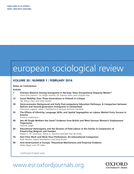-
Views
-
Cite
Cite
Hannah Zagel, Are All Single Mothers the Same? Evidence from British and West German Women’s Employment Trajectories, European Sociological Review, Volume 30, Issue 1, February 2014, Pages 49–63, https://doi.org/10.1093/esr/jct021
Close - Share Icon Share
Abstract
Single motherhood is often discussed as a reason for women’s non-employment. This article investigates women’s employment trajectories during and after single motherhood in the welfare state contexts of Britain and West Germany. Sequence analysis is applied to longitudinal data from the British Household Panel Survey (N = 329) and the German Socio-Economic Panel (N = 378), comparing patterns in employment trajectories within and across country contexts. The article finds that trajectories vary strongly across individuals, but can be grouped into eight distinctive clusters. Typical trajectories during and after single motherhood are spread unevenly among women in Britain and West Germany. It was found that overall there was higher labour market attachment in West Germany and a higher prevalence of volatile employment trajectories in Britain. The findings also suggest that policy approaches focusing on single motherhood may be well advised to further disaggregate the claimant category by accounting for the life-course positioning of this family situation.



